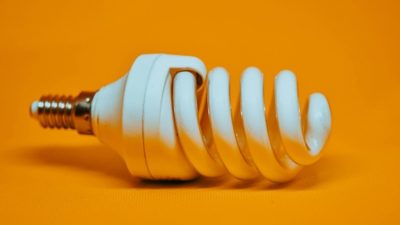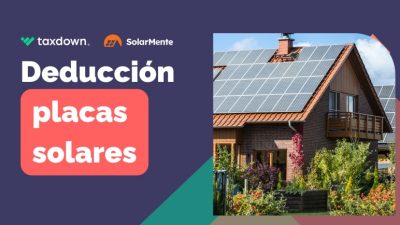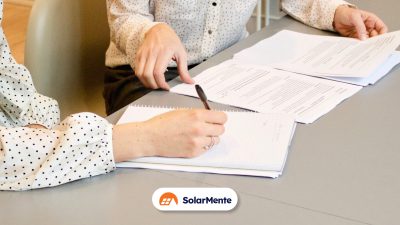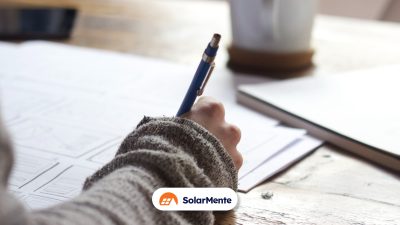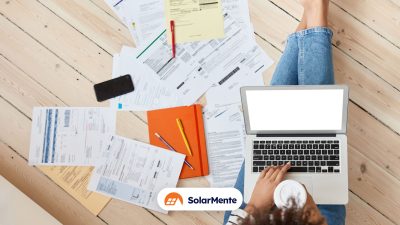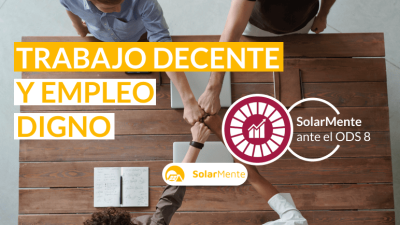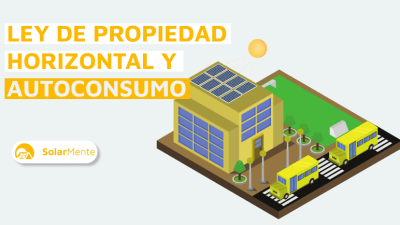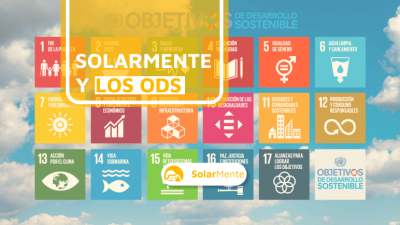Here you will find the answers to your questions about the reduced VAT on the installation of solar panels for self-consumption.
At SolarMente we want to keep you up to date with all the latest news that will help more people to switch to photovoltaic self-consumption.
Following the success of our blog on the IRPF deduction for installing solar panels, we have created this article to clarify the most common concerns regarding the tax rate applicable to the installation of solar panels for self-consumption, and in which cases a reduced VAT rate can be applied .
Here we present: 7 answers on the reduced VAT on the installation of solar panels for self-consumption.
1. What VAT applies to the installation of solar panels for self-consumption?
Generally,a VAT rate of 21% is applied to solar panels for self-consumption. A residential customer, i.e. a private individual, cannot offset the VAT against the invoice as a final consumer.
However, there are specific circumstances in which a reduced VAT rate of 10% may apply. However, care must be taken as it has very specific requirements.
2. In which cases can reduced VAT be applied to the installation of solar panels for self-consumption?
Applying a 10% VAT rate instead of 21% means a reduction of 11%.
In particular, it is important to know that the State Tax Administration Agency (Hacienda) only allows a reduced VAT rate of 10 % to be applied in the case of “rehabilitation, analogous or related works in buildings”.
In other words, it only allows installations that are part of a new building, a major renovation, or where solar panels or other energy equipment does not represent more than 40% of the cost of the building work.
3. What other conditions are there?
Specifically, Article 81 of Law 37/1992 of 28 December 1992 lays down the cases in which the reduced VAT rate of 10 % may be applied, which are as follows:
- The recipient of the repair or renovation work is a natural person and the dwelling is used for private use. It also includes homeowners’ associations. The regulation does not state that the dwelling must be a habitual residence, it only specifies that it must be used for private use, which, in principle, excludes its subsequent rental.
- The construction of the dwelling must have been completed within the two years prior to the start of the repair and renovation work. In other words, for a house where the repair work is due to start on 28 November 2022, the construction must have been completed before 28 November 2020.
- That the person in charge of carrying out the works does not provide materials or, if he does provide them, their cost does not exceed 40% of the total budget. This means that, in the case of a photovoltaic installation, the equipment must not exceed 40% of the total cost of the installation.
- Lastly, the 10 % rate of value added tax will be applied to work, with or without the supply of materials, resulting from contracts entered into directly between the developer and the contractor for the construction or renovation of buildings or parts thereof intended mainly for residential use, including the premises, annexes, garages, installations and ancillary services located therein. Buildings in which at least 50 % of the floor area is intended for residential use shall be considered to be mainly for residential use.
4. Does the tax authorities allow a reduced VAT rate of 10% for the installation of solar panels for self-consumption?
The Tax Agency (Inland Revenue) specifies that the reduced VAT rate of 10% instead of 21% can be applied for works incorporating equipment using renewable energy sources, but with restrictions.
It accepts that self-consumption photovoltaic installations should be taxed at a reduced VAT rate of 10% if they are part of a new building, a major renovation, or if the solar panels and other energy equipment do not represent more than 40% of the cost of the building work.
5. What are the consequences for those who do not comply with the reduced VAT law?
The clients will one day receive a letter from the tax authorities demanding the 11% that they have not paid.
If the inspectorate detects fraud, it can impose financial penalties and criminal liability.
6. Are there examples to clarify the cases in which the reduced VAT rate of 10% and the VAT rate of 21% could be applied?
To make it as clear as possible when reduced VAT might apply, we will look at examples where VAT should be applied at 10% and 21%.
3 examples of reduced VAT of 10% for self-consumption installations
✔️Si you are building your home as a self-builder which includes a self-consumption photovoltaic installation , as it is a “first supply” of housing, the reduced VAT rate of 10% can be applied .
✔️Si you are going to make an integral reform budgeted at €60,000 which includes the rehabilitation of structural parts (such as the replacement of interior stairs and windows) and part of the roof, including the installation of solar panels for self-consumption on the roof. The renovation of the structural parts is budgeted at 50.000€ (more than 25% of the value of the house and more than 50% of the value of the integral renovation); and the cost of the materials of the photovoltaic installation is 6.500€ (the materials of the photovoltaic installation do not exceed 40%). Then, the reduced VAT rate of 10% applies.
✔️Si you want to renovate the roof, downspout and photovoltaic installation and you have a budget of €40,000. If the materials that make up the entire renovation exceed €16,000 (40% of the total cost of the renovation), 21% VAT will be applied. If it does not exceed this amount, the reduced VAT rate is 10%.
3 examples of 21% VAT for self-consumption solar panel installations
✔️Si you are carrying out a complete renovation of a tourist flat, the general VAT rate of 21% applies because it is not a private dwelling but a business tourist facility.
✔️Si you want to do a refurbishment in which only the installation of solar panels for self-consumption is to be carried out. The installation has a cost of €7,500, of which €6,000 are the materials themselves to install, then the 21% VAT rate should be applied, as it does not meet the requirement that the installation materials do not exceed 40% of the cost of the entire work.
✔️Si if you want to buy a self-consumption kit and install it yourself, 21% VAT applies, because it is not a refurbishment.
7. Are there other developments with regard to reduced VAT for renewable energies?
Yes, the year 2021 has ended with the news that the European Union (EU) is determined to boost the self-consumption energy market through public subsidies and fiscal measures, such as a reduced VAT on solar panels. Specifically, the EU is proposing a VAT rate of between 0 and 5% for solar panels for residential use and in public buildings in order to accelerate the energy transition and reduce CO2 emissions.
Thus, from now on, governments will have more flexibility in the types of tax measures they can apply, as long as they are adapted to common EU priorities, such as the fight against climate change. Therefore, Spain will be able to reduce – if it so wishes – the VAT on solar panels for residential self-consumption and in public buildings.
At SolarMente we focus on customer service and the quality of your experience. Therefore, we hope to have answered your questions about the VAT rate to be paid for the installation of solar panels for self-consumption and to understand when the reduced VAT applies .
However, if you still have any questions , please contact us without obligation.
Make it SolarMente! ☀️✌️






